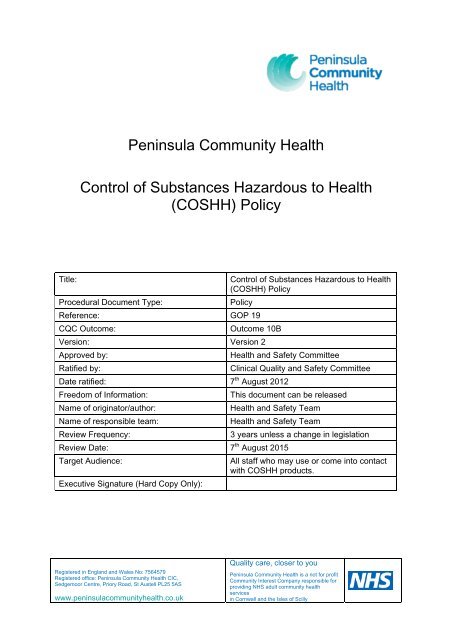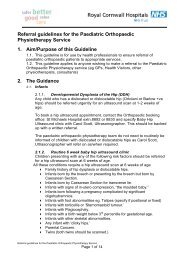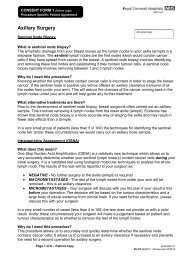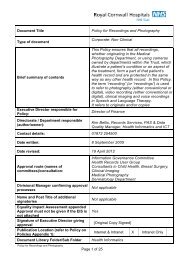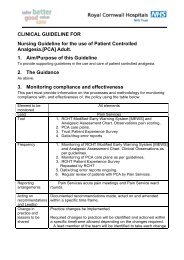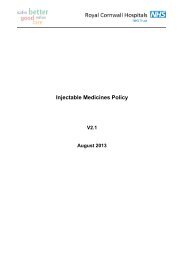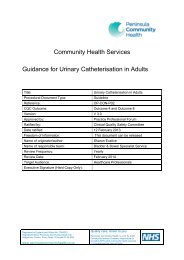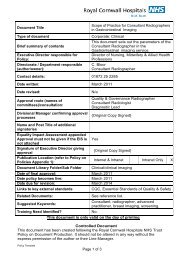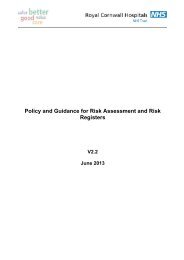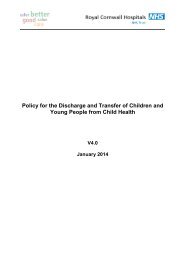(COSHH) Policy - the Royal Cornwall Hospitals Trust website...
(COSHH) Policy - the Royal Cornwall Hospitals Trust website...
(COSHH) Policy - the Royal Cornwall Hospitals Trust website...
You also want an ePaper? Increase the reach of your titles
YUMPU automatically turns print PDFs into web optimized ePapers that Google loves.
Peninsula Community Health<br />
Control of Substances Hazardous to Health<br />
(<strong>COSHH</strong>) <strong>Policy</strong><br />
Title:<br />
Control of Substances Hazardous to Health<br />
(<strong>COSHH</strong>) <strong>Policy</strong><br />
Procedural Document Type:<br />
<strong>Policy</strong><br />
Reference: GOP 19<br />
CQC Outcome:<br />
Outcome 10B<br />
Version: Version 2<br />
Approved by:<br />
Health and Safety Committee<br />
Ratified by:<br />
Clinical Quality and Safety Committee<br />
Date ratified: 7 th August 2012<br />
Freedom of Information:<br />
This document can be released<br />
Name of originator/author:<br />
Health and Safety Team<br />
Name of responsible team:<br />
Health and Safety Team<br />
Review Frequency:<br />
3 years unless a change in legislation<br />
Review Date: 7 th August 2015<br />
Target Audience:<br />
All staff who may use or come into contact<br />
with <strong>COSHH</strong> products.<br />
Executive Signature (Hard Copy Only):<br />
Registered in England and Wales No: 7564579<br />
Registered office: Peninsula Community Health CIC,<br />
Sedgemoor Centre, Priory Road, St Austell PL25 5AS<br />
www.peninsulacommunityhealth.co.uk<br />
Quality care, closer to you<br />
Peninsula Community Health is a not for profit<br />
Community Interest Company responsible for<br />
providing NHS adult community health<br />
services<br />
in <strong>Cornwall</strong> and <strong>the</strong> Isles of Scilly
Contents<br />
1. Introduction ........................................................................................................... 3<br />
2. Definitions ............................................................................................................. 3<br />
2.1 Terminology ................................................................................................ 4<br />
2.3 Substance Identification .............................................................................. 4<br />
2.4 Hierarchy Of Preferred Control.................................................................... 5<br />
2.5 Occupational Exposure Limit....................................................................... 6<br />
3. Duties .................................................................................................................... 6<br />
4.0 Management of <strong>COSHH</strong> .................................................................................... 10<br />
4.1 <strong>COSHH</strong> Risk Assessment......................................................................... 11<br />
4.2 MONITORING........................................................................................... 12<br />
4.3 HEALTH SURVEILLANCE........................................................................ 12<br />
4.4 RECORD KEEPING.................................................................................. 12<br />
5. <strong>COSHH</strong> <strong>Policy</strong> Implementation ........................................................................... 13<br />
5.1 Implementation & Dissemination................................................................ 13<br />
5.2 Training and Support.................................................................................. 13<br />
5.3 Document Control & Archiving Arrangements........................................... 13<br />
5.4 Equality Impact Assessment ..................................................................... 13<br />
5.5 Process for Monitoring Effective Implementation ...................................... 13<br />
6. Associated Documentation.................................................................................. 14<br />
Please Note <strong>the</strong> Intention of this Document<br />
This policy outlines Peninsula Community Health’s processes and protocols for <strong>the</strong><br />
management and control of substances hazardous to health to ensure <strong>the</strong> safety of<br />
all staff, patients and visitors.<br />
Review and Amendment Log<br />
Version No Type of Change Date Description of change<br />
2 of 22
1. Introduction<br />
The Health and Safety at Work Act 1974 requires that “every employer” shall make<br />
arrangements for securing, so far as is reasonably practicable, safety and absence<br />
of risk to health in connection with <strong>the</strong> use, handling, storage and transport of articles<br />
and substances.<br />
This duty is extended to and clarified for substances hazardous to health under <strong>the</strong><br />
Control of Substances Hazardous to Health Regulations 2002 (<strong>COSHH</strong>) (as<br />
amended).<br />
Under <strong>the</strong> <strong>COSHH</strong> Regulations, Peninsula Community Health is required to make an<br />
assessment of heath risks created by work involving hazardous substances.<br />
Where risks are identified, Peninsula Community Health must carry out a risk<br />
assessment, take action to prevent or control exposure to those substances, monitor<br />
exposure and provide information, instruction and training for those who may be<br />
exposed.<br />
2. Definitions<br />
Employer is Peninsula Community Health (PCH)<br />
Employees are persons working for PCH, to include contingent workforce / agency<br />
/ personnel on work experience and volunteer workers.<br />
Hazard is something with <strong>the</strong> potential to cause harm, injury, illness, disease or<br />
loss.<br />
Risk is <strong>the</strong> likelihood of harm, injury, illness or loss from a particular hazard is<br />
realised. Risk reflects both <strong>the</strong> likelihood of occurrence and it’s severity of outcome,<br />
for example, through an unexpected event happening that may ei<strong>the</strong>r cause harm or<br />
have an impact upon PCH patients, employees, contractors, visitors including <strong>the</strong><br />
general public.<br />
Risk Assessment is <strong>the</strong> process whereby hazards are identified and <strong>the</strong> level of<br />
risk identified is evaluated.<br />
A hazardous substance can be defined as one which meets any of <strong>the</strong> following<br />
criteria:<br />
A substance that is classed as very toxic, toxic, harmful, corrosive or irritant<br />
under <strong>the</strong> Chemical (Hazard Information and Packaging for Supply) Regulations<br />
2009 (CHIP).<br />
A biological agent meaning any micro-organism, cell culture or human<br />
endoparasite which may cause or create a hazard to human health<br />
A substance listed as carcinogenic in <strong>the</strong> regulations.<br />
A substance which already has an allocated Workplace Exposure Limit (WEL)<br />
3 of 22
Significant quantities of any kind of dust.<br />
Any o<strong>the</strong>r substances capable of creating comparable risks to health to those<br />
listed above.<br />
2.1 Terminology<br />
Those persons with responsibilities for Health and Safety and <strong>the</strong> <strong>COSHH</strong><br />
regulations should make <strong>the</strong>mselves aware of <strong>the</strong> terms used, as this will promote a<br />
better understanding of those responsibilities.<br />
Substance type<br />
A substance hazardous to health can be found in any of <strong>the</strong> following forms: -<br />
Hazard<br />
Liquid Gas Fume Solid<br />
Aerosols Vapour Dust Micro-organism<br />
The hazard presented by a substance is its potential to cause harm, which can be<br />
through:<br />
Inhalation (through dust, vapours, fumes etc)<br />
Ingestion (directly from swallowing or indirectly from settlement on hands<br />
etc.)<br />
Absorbed through <strong>the</strong> skin (directly or from contaminated surfaces or<br />
clothing)<br />
Injected into <strong>the</strong> body (by high pressure or contaminated sharps)<br />
Risk<br />
The risk from a substance is <strong>the</strong> likelihood that it will cause harm whilst being used<br />
or stored and will depend on: -<br />
The hazard presented by <strong>the</strong> substance<br />
How it is used or stored<br />
How it is controlled<br />
Who is exposed, what <strong>the</strong>y are exposed to, for how long and how much<br />
and what activity <strong>the</strong>y are doing<br />
2.2 Substance Identification<br />
Substances can be found in a variety of containers including drums, bottles and<br />
packages etc. However, not all of <strong>the</strong>se contain substances that are hazardous to<br />
health.<br />
The labels on products that have been identified as “Substances Hazardous to<br />
Health” can be readily identified from those that are not, as <strong>the</strong>y display specific<br />
pictorial symbols indicating <strong>the</strong> hazard <strong>the</strong>y pose. For example, a black cross on an<br />
orange background, meaning that substance is Harmful or Irritant. The symbol will<br />
4 of 22
also carry <strong>the</strong> wording as appropriate. The labels will also display risk or safety<br />
phrases that identify <strong>the</strong> hazard and risk. This is a legal requirement under <strong>the</strong><br />
Chemical (Hazard Information and Packaging for Supply) Regulations 2009 (CHIP).<br />
GHS Regulation (Globally Harmonised System for <strong>the</strong> Classification and Labelling of<br />
Chemicals) is a new European Regulation on <strong>the</strong> classification and labelling of<br />
hazardous chemicals based on UN GHS agreement. There is a transition period up<br />
until June 2015 and will replace <strong>the</strong> Dangerous Substances Directive and Dangerous<br />
Preparations Directive (implemented in <strong>the</strong> UK as <strong>the</strong> Chemicals Hazard Information<br />
and Packaging for Supply (CHIP) Regulation). This new regulation Introduces new<br />
scientific criteria to assess <strong>the</strong> hazardous properties of chemicals, new hazard<br />
warning symbols (called pictograms) and new hazard warning symbols.<br />
2.3 Hierarchy Of Preferred Control<br />
The first letter of <strong>the</strong> acronym <strong>COSHH</strong> stands for control and one of <strong>the</strong> objectives is<br />
to improve <strong>the</strong> control of exposure. The first requisite of control is <strong>the</strong> recognition that<br />
<strong>the</strong>re is an exposure which needs to be controlled. The formal risk assessment<br />
process will lead to this recognition, <strong>the</strong> regulations set out a hierarchy to obtain and<br />
maintain control by:-<br />
‣ Elimination Can <strong>the</strong> job be done without using <strong>the</strong> substance<br />
‣ Substitution<br />
‣ Control<br />
Using a substance which is non-hazardous or less hazardous to<br />
health<br />
By mechanical means, change or modifying a system<br />
‣ Protection<br />
Use of Personal Protective Equipment (PPE), as a last resort<br />
Risk phrases<br />
These identify <strong>the</strong> hazard. For example: -<br />
R26 Toxic by Inhalation<br />
R36 Irritating to <strong>the</strong> eyes<br />
5 of 22
Or<br />
Safety phases<br />
These give advice on how to minimise <strong>the</strong> risk. For example: -<br />
S15 Keep away from heat<br />
S24 Avoid contact with <strong>the</strong> skin<br />
2.4 Occupational Exposure Limit<br />
Under <strong>COSHH</strong>, Workplace Exposure Limits (WEL) have been established for a<br />
number of substances hazardous to health. A WEL is <strong>the</strong> maximum concentration of<br />
an airborne substance averaged over a referenced period.<br />
WEL’s are intended to prevent excessive exposure to specific hazardous substances<br />
by containing exposure below a set limit.<br />
3. Duties<br />
The Chief Executive / Executive Board<br />
a) The Chief Executive of <strong>the</strong> organisation, as Accountable Officer, is ultimately<br />
responsible for health and safety.<br />
b) The PCH Board will delegate responsibility for <strong>the</strong> implementation of safe working<br />
practices to Managers within <strong>the</strong> organisation.<br />
Executive Directors<br />
a) Are responsible, delegated from <strong>the</strong> Chief Executive, for <strong>the</strong> health and safety at<br />
work of all employees, patients, contractors, visitors and o<strong>the</strong>rs<br />
b) They should ensure that <strong>the</strong> organisation is fully compliant with <strong>the</strong> requirements<br />
of <strong>the</strong> Health & Safety at Work etc. Act 1974, all o<strong>the</strong>r relevant legislation and<br />
Codes of Practice, ensuring that support is given to all persons to whom<br />
responsibility has been delegated.<br />
Senior Managers<br />
Senior Managers are responsible for <strong>the</strong> health, safety and welfare at work of <strong>the</strong>ir<br />
managers, staff and o<strong>the</strong>rs with regard to <strong>the</strong> risks to <strong>the</strong>ir health and safety<br />
associated with substances hazardous to health and will ensure: -<br />
That <strong>the</strong>ir managers and staff follow <strong>the</strong> PCH policy and procedures relating<br />
to <strong>COSHH</strong>.<br />
6 of 22
They have detailed local health and safety documentation in place that<br />
allocates specific responsibilities to enable <strong>the</strong>m to comply with <strong>the</strong> policy on<br />
<strong>COSHH</strong>.<br />
Ensure that <strong>COSHH</strong> Risk Assessments are carried out, recorded and that<br />
employees are informed of <strong>the</strong> significant risks identified; and that <strong>the</strong><br />
protective and preventative measures required to protect <strong>the</strong>mselves and<br />
o<strong>the</strong>rs from risks arising from <strong>the</strong> use and storage of substances hazardous to<br />
health are implemented.<br />
That to support risk assessments, action plans are completed, implemented<br />
and reviewed to ensure <strong>the</strong> elimination or reduction of <strong>the</strong> risks identified and<br />
that any residual risks are placed on <strong>the</strong> PCH Risk Register as appropriate.<br />
That staff are trained to <strong>the</strong> appropriate level to deal with <strong>the</strong> risks identified<br />
through <strong>the</strong> assessment process and that records of all such training are<br />
documented and maintained.<br />
Involvement with <strong>the</strong> Health and Safety team in any policy amendments and<br />
updates issued from time to time and in any programmes of inspection or<br />
audit, bringing <strong>the</strong>se to <strong>the</strong> attention of staff, as appropriate.<br />
Line Managers and Supervisors will ensure: -<br />
There is information available on toxicity and potential hazards for substances<br />
in use within <strong>the</strong>ir area of control, which will include <strong>the</strong> Material Safety Data<br />
sheets for each substance. This information must be available for staff, and<br />
managers should ensure that staff are aware how to access it.<br />
That an up-to-date register of <strong>COSHH</strong> products for <strong>the</strong>ir own area of control is<br />
kept and maintained.<br />
<br />
They undertake suitable and sufficient <strong>COSHH</strong> Risk Assessments for <strong>the</strong>ir<br />
area of control; this task may be delegated, but must be undertaken by a<br />
member of staff within <strong>the</strong> department deemed to be competent<br />
Where Risks have been identified ei<strong>the</strong>r through <strong>the</strong> risk assessment or<br />
o<strong>the</strong>rwise <strong>the</strong>y are to ensure: -<br />
a) That in areas which are identified as high risk, suitable warning signs are<br />
displayed giving suitable and sufficient advice on <strong>the</strong> hazards and<br />
appropriate safeguards to be taken.<br />
b) That all substances are correctly labelled, that packaging is intact and <strong>the</strong><br />
expiry date is prominently displayed.<br />
They seek advice and guidance and liaise with <strong>the</strong> Infection Control or<br />
Occupational Health Department (as appropriate) on all aspects of <strong>COSHH</strong><br />
involving biological agents<br />
<br />
They liaise with <strong>the</strong> <strong>Cornwall</strong> Healthcare Estates & Support Services<br />
(CHESS) or <strong>the</strong> Medical Physics Department on all aspects of <strong>COSHH</strong><br />
involving <strong>the</strong> inspection, maintenance and testing of machinery and<br />
equipment used as a control measure under <strong>COSHH</strong>.<br />
7 of 22
They arrange Health Surveillance through <strong>the</strong> Occupational Health<br />
Department where appropriate.<br />
Liaison with <strong>the</strong> organisation’s Health and Safety Team on environmental<br />
monitoring where required.<br />
That where <strong>the</strong> use of Personal Protective Equipment (PPE) is identified, <strong>the</strong><br />
correct type and size of equipment is selected in liaison with <strong>the</strong> Health and<br />
Safety team.<br />
That all persons who are provided with PPE receive instruction, training and<br />
information considered necessary on <strong>the</strong> function, correct use and<br />
maintenance in liaison with <strong>the</strong> Health and Safety team.<br />
That appropriate instruction, training and information on <strong>the</strong> safe handling,<br />
transportation, packaging, storage and use of substances or equipment used<br />
in conjunction with substances hazardous to health is arranged or provided.<br />
They review <strong>the</strong> risk assessments carried out in <strong>the</strong> areas under <strong>the</strong>ir control.<br />
This review should be on an annual basis; when <strong>the</strong> assessment is no longer<br />
valid, or when <strong>the</strong>re has been a significant change in <strong>the</strong> work to which <strong>the</strong><br />
assessment relates.<br />
They keep up to date any such records as required under <strong>the</strong> regulations for<br />
<strong>the</strong> requisite period of time.<br />
Employees will ensure <strong>the</strong>y: -<br />
Make <strong>the</strong>mselves fully aware of <strong>the</strong> PCH <strong>COSHH</strong> <strong>Policy</strong>, <strong>COSHH</strong> risk<br />
assessments and any safety precautions appertaining to <strong>the</strong> use, storage and<br />
transportation of a substance hazardous to health that <strong>the</strong>y use or handle at<br />
work.<br />
<br />
<br />
Wear Personal Protective equipment (PPE) when it is provided and ensure<br />
that it is stored and maintained when not in use and that any defects are<br />
promptly reported to line manager.<br />
Attend training when it has been arranged for <strong>the</strong>m.<br />
Report to <strong>the</strong>ir Line Manager and following up with a report through DATIX<br />
of:-<br />
a) Incident of a spillage involving a hazardous substance to health<br />
b) Failure or deterioration of a control measure<br />
c) Shortage or inadequacy of PPE<br />
Health and Safety Team<br />
<br />
Will monitor and audit <strong>COSHH</strong> procedure.<br />
8 of 22
Will facilitate general training in <strong>COSHH</strong> that has been arranged through Line<br />
Managers and/or <strong>the</strong> Education and Training Department. This will encourage<br />
cascade training and result in greater understanding by managers and staff of<br />
<strong>the</strong> <strong>Trust</strong>’s compliance requirements of <strong>COSHH</strong>.<br />
Provide specialist advice and guidance as and when appropriate to individual<br />
departments.<br />
In liaison with managers provide advice and information to ensure <strong>the</strong> safe<br />
packaging, handling, transportation, storage and use of substances and in <strong>the</strong><br />
use of equipment used in conjunction with substances hazardous to health,<br />
for all staff or persons likely to be affected by such activities.<br />
Assist Managers in <strong>the</strong> correct selection of Personal Protective Equipment<br />
(PPE).<br />
<br />
Assist line managers in carrying out environmental monitoring tasks and in <strong>the</strong><br />
making and keeping of all records for <strong>the</strong> appropriate period of time.<br />
CHESS or Medical Physics Department will ensure: -<br />
That all plant, machinery and equipment for which <strong>the</strong>y have responsibility<br />
under <strong>COSHH</strong> is inspected, maintained and tested to <strong>the</strong> appropriate<br />
standards / time scales as set out in <strong>the</strong> regulations or o<strong>the</strong>r legislative or<br />
mandatory requirements.<br />
They notify both <strong>the</strong> Line Manager and <strong>the</strong> Health and Safety team if any<br />
plant, machinery or equipment falls short of <strong>the</strong> standards to which it was<br />
designed as a control measure under <strong>COSHH</strong> and that, as a result may give<br />
rise to an exposure to a substance hazardous to health.<br />
The Waste Department will ensure: -<br />
They provide advice on <strong>the</strong> disposal of substances covered by <strong>COSHH</strong><br />
regulations and keep <strong>the</strong> Waste Management <strong>Policy</strong> up-to-date to reflect any<br />
changes to <strong>the</strong> regulations.<br />
<strong>Trust</strong> Dangerous Goods Safety Adviser will:-<br />
Provide advice on safe transportation of <strong>COSHH</strong> items designated as<br />
dangerous for carriage.<br />
The Supplies Department will ensure: -<br />
<br />
They provide Material Safety Data Sheets (MSDS) for use in <strong>the</strong> <strong>COSHH</strong> Risk<br />
assessments for substances ordered through <strong>the</strong>ir department. All o<strong>the</strong>r<br />
9 of 22
They notify <strong>the</strong> Health and Safety team if a new item has been ordered that is<br />
covered by <strong>the</strong> <strong>COSHH</strong> Regulations.<br />
The Infection Control Department will ensure: -<br />
<br />
<br />
They provide practical advice and guidance on microbiological agents<br />
covered by <strong>the</strong> <strong>COSHH</strong> regulations.<br />
In liaison with Line Managers, carry out environmental monitoring on<br />
microbiological agents, as appropriate and in accordance with statutory and<br />
mandatory requirements and inform <strong>the</strong> relevant line managers and <strong>the</strong><br />
Health and Safety team of <strong>the</strong> results.<br />
Serious problems relating to health and safety issues will be reported to <strong>the</strong><br />
Health and Safety team.<br />
Keep and maintain all such records of any monitoring carried out under<br />
statutory or mandatory requirements.<br />
The Occupational Health Department will ensure: -<br />
They carry out biological monitoring and health surveillance as required and<br />
keep all records for <strong>the</strong> specified time.<br />
They will liaise with line managers, <strong>the</strong> Infection Control Department and<br />
Health and Safety team, as appropriate for <strong>the</strong> protection of health of all<br />
employees.<br />
4.0 Management of <strong>COSHH</strong><br />
Peninsula Community Health is committed to protecting <strong>the</strong> Health and Safety of its<br />
employees and o<strong>the</strong>rs, so far as reasonably practicable, and will ensure:<br />
The collection of information on toxicity and potential hazards, and keep and<br />
maintain an up to date registry on substances in use within <strong>the</strong> organisation,<br />
which will include <strong>the</strong> Material Safety Data sheets for each substance.<br />
Risk assessments are carried out where any work is liable to expose an<br />
employee to any substance hazardous to health and, as a result of that<br />
assessment, take all steps necessary to eliminate, reduce, prevent or control<br />
any exposure.<br />
That any control measures, which exist or are introduced as a result of <strong>the</strong><br />
risk assessment are maintained, examined and tested to <strong>the</strong> required<br />
timescales and that <strong>the</strong>y are correctly used or applied.<br />
10 of 22
Monitoring of <strong>the</strong> workplace is carried out to ensure adequate control is<br />
maintained for protecting <strong>the</strong> health of employees.<br />
Information is available and accessible to employees on <strong>the</strong> risks identified as<br />
a result of <strong>the</strong> risk assessment including any protective or preventative<br />
measures and that staff know how to access this information.<br />
That any personal protective equipment (PPE) that is issued is of <strong>the</strong><br />
approved type and is correctly maintained and worn.<br />
Health Surveillance (where appropriate) to protect <strong>the</strong> health of employees is<br />
undertaken through <strong>the</strong> Occupational Health Department.<br />
Risk Assessments carried out under <strong>the</strong> regulations are reviewed on a regular<br />
basis, or when <strong>the</strong> assessment is no longer valid or <strong>the</strong>re has been a<br />
significant change in <strong>the</strong> work to which <strong>the</strong> assessment relates.<br />
Implementation or any changes that are required as a result of <strong>the</strong> Risk<br />
Assessment review.<br />
Any such records as required under <strong>the</strong> regulations are made and kept up to<br />
date.<br />
4.1 <strong>COSHH</strong> Risk Assessment<br />
Line managers are responsible for carrying out <strong>COSHH</strong> risk assessments enabling<br />
decisions to be made about <strong>the</strong> use of substances in <strong>the</strong> workplace and <strong>the</strong> handling<br />
of clinical waste, and <strong>the</strong> use of appropriate controls to ensure safety and improve<br />
<strong>the</strong> working environment.<br />
The <strong>COSHH</strong> procedural documentation process consists of: -<br />
<strong>COSHH</strong> Risk Assessment Summary<br />
Prioritised Action Plan<br />
Risk Matrix<br />
(This documentation can be found at <strong>the</strong> end of this policy)<br />
PROCEDURE FOR RISK ASSESSMENT & CONTROL<br />
1. Initially, <strong>the</strong> staff member carrying out <strong>the</strong> assessment must compile a<br />
Summary List of substances (see Appendix A) used in <strong>the</strong> area for which<br />
<strong>the</strong>y are responsible and obtain <strong>the</strong> Material Safety Data sheet (MSDS),<br />
sometimes called Hazard Data Sheet for each of <strong>the</strong> substances being<br />
assessed. See Appendix D - checklist to assist this process.<br />
2. Taking each substance to be assessed in turn, check <strong>the</strong> MSDS and label for<br />
that substance, to determine if it is classified as a substance hazardous to<br />
11 of 22
3. Hazards identified as Medium / High / Extreme should have a supporting<br />
action plan to identify control measures to be implemented (see Appendix B).<br />
4. Any new substances, which are brought into <strong>the</strong> area under <strong>the</strong> line<br />
managers’ control, will have to be Risk Assessed by <strong>the</strong>m prior to <strong>the</strong><br />
substance being put into use and added to <strong>the</strong> summary form as detailed<br />
previously in <strong>the</strong> procedures.<br />
5. Managers are to ensure that <strong>the</strong> Health and Safety team are kept informed of<br />
any new or altered processes or new substances likely to give rise to<br />
exposure to a substance hazardous to health.<br />
4.2 MONITORING<br />
Monitoring of atmospheric concentrations to which a member of staff is exposed<br />
when undertaking a task should be carried out where: -<br />
1. The <strong>COSHH</strong> risk assessment indicates <strong>the</strong> level of risk identified .<br />
2. The effectiveness of environmental control measures in <strong>the</strong> work area need to<br />
be re-evaluated<br />
3. There is a need to demonstrate that <strong>the</strong> Workplace Exposure Limit (WEL) has<br />
not been exceeded.<br />
4. The effectiveness of Local Exhaust Ventilation (LEV) needs to be assessed at<br />
regular intervals as required by statutory of mandatory requirements<br />
Biological monitoring may be used for: -<br />
1. Surveillance of those who are, or may be, exposed at work to substances<br />
hazardous to health, in <strong>the</strong> normal course of <strong>the</strong>ir work.<br />
2. Examination of those who are unexpectedly exposed or subjected to risk of<br />
exposure as a result of an accident.<br />
3. Continuing evaluation of environmental and internal dose control limits<br />
4.3 HEALTH SURVEILLANCE<br />
This is carried out on employees where <strong>the</strong>y have been exposed to concentrates of<br />
a substance hazardous to health that is listed in <strong>the</strong> schedule to <strong>the</strong> <strong>COSHH</strong><br />
Regulations. It is carried out in conjunction with <strong>the</strong> Occupational Health Department.<br />
4.4 RECORD KEEPING<br />
12 of 22
<strong>COSHH</strong> risk assessments records and occupational hygiene/monitoring reports<br />
along with health surveillance records should be kept for a period of not less than 40<br />
years.<br />
5. <strong>COSHH</strong> <strong>Policy</strong> Implementation<br />
5.1 Implementation & Dissemination<br />
The implementation and effectiveness of this policy will be monitored through <strong>the</strong><br />
Health and Safety Committee.<br />
5.2 Training and Support<br />
Training should include:<br />
Chemical data and information (usually through <strong>the</strong> MSDS) on <strong>the</strong> substances<br />
involved, <strong>the</strong>ir hazards, and <strong>the</strong> action to be taken should a spill or<br />
contamination occur.<br />
The correct use and maintenance of PPE<br />
Information on <strong>the</strong> correct storage and safe transportation of material<br />
Correct disposal of waste<br />
5.3 Document Control & Archiving Arrangements<br />
Once ratified, this policy will be loaded to <strong>the</strong> documents library. Any previous<br />
versions will be electronically archived by <strong>the</strong> <strong>Policy</strong> Administrator in <strong>the</strong> electronic<br />
<strong>Policy</strong> Drive Archive Folder.<br />
A signed hard copy of <strong>the</strong> policy will be forwarded to <strong>the</strong> <strong>Policy</strong> Administrator and an<br />
electronic copy will be saved by <strong>the</strong> <strong>Policy</strong> Administrator in <strong>the</strong> electronic <strong>Policy</strong><br />
Drive. Fur<strong>the</strong>r copies of current and archived policies can be obtained from <strong>the</strong><br />
<strong>Policy</strong> Administrator including versions in large print, Braille and o<strong>the</strong>r languages.<br />
5.4 Equality Impact Assessment<br />
Peninsula Community Health aims to design and implement services, policies and<br />
measures that meet <strong>the</strong> diverse needs of our service, population and workforce,<br />
ensuring that none are placed at a disadvantage over o<strong>the</strong>rs.<br />
As part of its development, this strategy and its impact on equality have been<br />
assessed. The assessment is to minimise and if possible remove any<br />
disproportionate impact on employees on <strong>the</strong> grounds of race sex, disability, age,<br />
sexual orientation or religious belief. No detriment was identified.<br />
5.5 Process for Monitoring Effective Implementation<br />
A <strong>COSHH</strong> audit will be completed at least every three years to ensure compliance<br />
with <strong>the</strong> policy in all areas of <strong>the</strong> organisation. This audit will be carried out by <strong>the</strong><br />
13 of 22
health and safety team. Any learning from <strong>the</strong> audits will be collated and fed back to<br />
staff and if necessary will be incorporated within <strong>the</strong> policy by an amendment.<br />
6. Associated Documentation / references<br />
This document references <strong>the</strong> following supporting documents which should be<br />
referred to in conjunction with <strong>the</strong> document being developed.<br />
Health & Safety Management Strategy<br />
Health & Safety <strong>Policy</strong><br />
Guide to Risk Assessment<br />
Generic Waste <strong>Policy</strong><br />
Management of Contractors and Estates Projects <strong>Policy</strong><br />
Health & Safety at Work etc Act 1974<br />
Reporting of Injuries, Disease and Dangerous Occurrences Regulation 1995<br />
Disability Discrimination Act 1995<br />
Control of Substances Hazardous to Health 2002 (as amended)<br />
Chemicals (Hazard Information and Packaging for Supply) Regulations 2009<br />
Registration, Evaluation, Authorisation and restriction of Chemicals Regulations<br />
(REACH)<br />
Personal Protective Equipment at Work Regulations 1992<br />
Management of Health and Safety at Work Regulations 1999<br />
Occupational Exposure Limits EH40<br />
14 of 22
Appendix A<br />
CONTROL OF SUBSTANCES HAZARDOUS TO HEALTH REGULATIONS 2002<br />
SUMMARY LIST OF <strong>COSHH</strong> ASSESSMENTS<br />
Hospital /Health Office/Site:<br />
Item<br />
No<br />
Substance Quantity Freq. Of<br />
Use<br />
Ward/Dept:<br />
Ext:<br />
Duration of<br />
Exposure<br />
Persons<br />
Exposed<br />
Assessors:<br />
Title:<br />
Hazards to Health<br />
Assessment Date:<br />
Review Date:<br />
Overall<br />
Risk Numerical risk<br />
Ranking ranking<br />
E,H,M,L Impact Likelihood<br />
<strong>COSHH</strong> Hazard Data Sheets should accompany <strong>the</strong> <strong>COSHH</strong> Assessments<br />
Hazards identified as Med High should have a supporting Risk assessment and action plan
Appendix B<br />
ACTION PLAN FOR AREAS OF RISK<br />
Hosp/Health office: Activity/topic: Ward/Dept/Area:<br />
Ext:<br />
Risk<br />
Assess<br />
ment<br />
Item<br />
No*<br />
Hazard*<br />
Action to be implemented to<br />
improve control of risk<br />
Responsible<br />
Person(s)<br />
Assessors:<br />
Title:<br />
Revised numerical<br />
Timescale Risk Ranking<br />
(to be assessed &<br />
reviewed as action<br />
progresses / completes **)<br />
Action Plan Date:<br />
Review Date:<br />
Overall<br />
residual<br />
risk rating<br />
Impact Likely E, H,<br />
M , L<br />
Risk<br />
Register<br />
ref. No.<br />
(for use by<br />
Managers/<br />
RASH<br />
Team)
Appendix C<br />
PENINSULA COMMUNITY HEALTH: RISK MATRIX 1<br />
TABLE 1: RISK IMPACT/CONSEQUENCE SCORE: Choose <strong>the</strong> most appropriate domain for <strong>the</strong> identified risk from <strong>the</strong> left hand side of<br />
<strong>the</strong> table Then work along <strong>the</strong> columns in same row to assess <strong>the</strong> severity of <strong>the</strong> risk on <strong>the</strong> scale of 1 to 5 to determine <strong>the</strong> consequence score,<br />
which is <strong>the</strong> number given at <strong>the</strong> top of <strong>the</strong> column.<br />
Consequence score (severity levels) and examples of descriptors<br />
Domains Negligible (1) Minor (2) Moderate (3) Major (4) Catastrophic (5)<br />
Impact on <strong>the</strong><br />
safety of<br />
patients, staff<br />
or public<br />
(physical/<br />
Minimal injury<br />
requiring no/minimal<br />
intervention or<br />
treatment.<br />
No time off work<br />
Minor injury or illness,<br />
requiring minor<br />
intervention<br />
Requiring time off work<br />
for less than 3 days<br />
psychological<br />
Increase in length of<br />
harm)<br />
hospital stay by 1-3<br />
days<br />
Quality/<br />
complaints/<br />
audit<br />
Peripheral element of<br />
treatment or service<br />
suboptimal<br />
Informal<br />
complaint/inquiry<br />
Overall treatment or<br />
service suboptimal<br />
Formal complaint<br />
(stage 1)<br />
Local resolution<br />
Single failure to meet<br />
internal standards<br />
Minor patient safety<br />
implications if<br />
unresolved<br />
Reduced performance<br />
rating if unresolved<br />
Moderate injury<br />
requiring professional<br />
intervention<br />
Requiring time off work<br />
for 3-14 days<br />
Increase in length of<br />
hospital stay by 4-15<br />
days<br />
RIDDOR/agency<br />
reportable incident<br />
Event impacts on a<br />
small number of<br />
patients<br />
Treatment or service<br />
has significantly<br />
reduced effectiveness<br />
Formal complaint<br />
(stage 2)<br />
Local resolution (with<br />
potential to go to<br />
independent review)<br />
Repeated failure to<br />
meet internal<br />
standards<br />
Major patient safety<br />
implications if findings<br />
are not acted on<br />
1 Taken from National Patient Safety Agency “Risk Matrix for Risk Managers” (January 2008)<br />
Major injury leading to<br />
long-term<br />
incapacity/disability<br />
Requiring time off work<br />
for over14 days<br />
Increase in length of<br />
hospital stay by over<br />
15 days<br />
Mismanagement of<br />
patient care with longterm<br />
effects<br />
Non-compliance with<br />
national standards with<br />
significant risk to<br />
patients if unresolved<br />
Multiple complaints/<br />
independent review<br />
Low performance rating<br />
Critical report<br />
Incident leading to<br />
death<br />
Multiple permanent<br />
injuries or irreversible<br />
health effects<br />
An event which impacts<br />
on a large number of<br />
patients<br />
Totally unacceptable<br />
level or quality of<br />
treatment/service<br />
Gross failure of patient<br />
safety if findings not<br />
acted on<br />
Inquest/ombudsman<br />
inquiry<br />
Gross failure to meet<br />
national standards
Human<br />
resources/<br />
organisational<br />
development/<br />
staffing/<br />
competence<br />
Statutory duty/<br />
inspections<br />
Adverse<br />
publicity/<br />
reputation<br />
Business<br />
objectives/<br />
projects<br />
Finance<br />
including<br />
claims<br />
Short-term low<br />
staffing level that<br />
temporarily reduces<br />
service quality (less<br />
than 1 day)<br />
No or minimal impact<br />
or breach of<br />
guidance/ statutory<br />
duty<br />
Rumours<br />
Potential for public<br />
concern<br />
Insignificant cost<br />
increase/ schedule<br />
slippage<br />
Small loss Risk of<br />
claim remote<br />
Low staffing level that<br />
reduces <strong>the</strong> service<br />
quality<br />
Breach of statutory<br />
legislation<br />
Reduced performance<br />
rating if unresolved<br />
Local media coverage -<br />
short-term reduction in<br />
public confidence<br />
Elements of public<br />
expectation not being<br />
met<br />
Up to 5 per cent over<br />
project budget<br />
Schedule slippage<br />
Loss of 0.1–0.25 per<br />
cent of budget<br />
Claim less than<br />
£10,000<br />
Late delivery of key<br />
objective/ service due<br />
to lack of staff<br />
Unsafe staffing level or<br />
competence (>1 day)<br />
Low staff morale<br />
Poor staff attendance<br />
for mandatory/key<br />
training<br />
Single breach in<br />
statutory duty<br />
Challenging external<br />
recommendations/<br />
improvement notice<br />
Local media coverage -<br />
long-term reduction in<br />
public confidence<br />
5–10 per cent over<br />
project budget<br />
Schedule slippage<br />
Loss of 0.25–0.5 per<br />
cent of budget<br />
Claim(s) between<br />
£10,000 and £100,000<br />
Uncertain delivery of<br />
key objective/service<br />
due to lack of staff<br />
Unsafe staffing level or<br />
competence (>5 days)<br />
Loss of key staff<br />
Very low staff morale<br />
No staff attending<br />
mandatory/ key<br />
training<br />
Enforcement action<br />
Multiple breaches in<br />
statutory duty<br />
Improvement notices<br />
Low performance rating<br />
Critical report<br />
National media<br />
coverage with 3 days<br />
service well below<br />
reasonable public<br />
expectation. MP<br />
concerned (questions<br />
in <strong>the</strong> House)<br />
Total loss of public<br />
confidence<br />
Incident leading to over<br />
25 per cent over<br />
project budget<br />
Schedule slippage<br />
Key objectives not met<br />
Non-delivery of key<br />
objective/ Loss of >1<br />
per cent of budget<br />
Failure to meet<br />
specification/ slippage<br />
Loss of contract /<br />
payment by results
Purchasers failing to<br />
pay on time<br />
Claim(s) over £1<br />
million<br />
Service/<br />
business<br />
interruption<br />
Environmental<br />
impact<br />
Loss/interruption of<br />
up to 1 hour<br />
Minimal or no impact<br />
on <strong>the</strong> environment<br />
Loss/interruption of up<br />
to 8 hours<br />
Minor impact on<br />
environment<br />
Loss/interruption of up<br />
to1 day<br />
Moderate impact on<br />
environment<br />
Loss/interruption of up<br />
to1 week<br />
Major impact on<br />
environment<br />
Permanent loss of<br />
service or facility<br />
Catastrophic impact on<br />
environment
TABLE 2: RISK LIKELIHOOD SCORE: What is <strong>the</strong> likelihood of <strong>the</strong> consequence occurring<br />
The frequency-based score is appropriate in most circumstances and is easier to identify. It should<br />
be used whenever it is possible to identify a frequency.<br />
The probability based score may be useful when rating risks associated with <strong>the</strong> success of timelimited<br />
or one-off project. For example, a three-year project cannot be expected to fail ‘once a<br />
month’, and <strong>the</strong> likelihood score will need to be assessed on <strong>the</strong> probability of adverse<br />
consequences occurring within <strong>the</strong> project’s time frame.<br />
Likelihood<br />
score<br />
1 2 3 4 5<br />
Descriptor Rare Unlikely Possible Likely<br />
Frequency<br />
How often<br />
might<br />
it/does it<br />
happen<br />
Probability.<br />
Will it<br />
happen or<br />
not<br />
This will<br />
probably<br />
never<br />
happen/rec<br />
ur<br />
Less than<br />
0.1%<br />
Do not<br />
expect it to<br />
happen/rec<br />
ur but it is<br />
possible it<br />
may do so<br />
Between<br />
0.1 %and<br />
1%<br />
Might<br />
happen or<br />
recur<br />
occasionally<br />
Between<br />
1% and<br />
10%<br />
Will<br />
probably<br />
happen/rec<br />
ur but it is<br />
not a<br />
persisting<br />
issue<br />
Between<br />
10% and<br />
50%<br />
Almost<br />
certain<br />
Will<br />
undoubtedly<br />
happen/rec<br />
ur, possibly<br />
frequently<br />
Over 50%<br />
TABLE 3: RISK RATING MATRIX<br />
Risk scoring = consequence x likelihood<br />
Consequence/<br />
Impact score<br />
Likelihood<br />
1 2 3 4 5<br />
Rare Unlikely Possible Likely<br />
Almost<br />
certain<br />
5 Catastrophic 5 10 15 20 25<br />
4 Major 4 8 12 16 20<br />
3 Moderate 3 6 9 12 15<br />
2 Minor 2 4 6 8 10<br />
1 Negligible 1 2 3 4 5<br />
The scores obtained from <strong>the</strong> risk matrix are assigned grades as follows<br />
1 - 3 Low risk<br />
4 - 6 Moderate risk<br />
8 - 12 High risk<br />
15 - 25 Extreme risk
Peninsula Community Health<br />
Appendix D<br />
RISK ASSESSMENT CHECKLIST FOR<br />
CONTROL OF SUBSTANCES HAZARDOUS TO HEALTH REGULATIONS 2002 (as amended)<br />
(<strong>COSHH</strong>)<br />
HOSPITAL:<br />
CLINIC/HEALTH OFFICE:<br />
Actual Workplace:<br />
Assessors<br />
Please answer <strong>the</strong> questions in <strong>the</strong> boxes provided below<br />
Name of substance<br />
Health and Safety Team<br />
Recommendations/Comments<br />
Chemical or o<strong>the</strong>r names (if appropriate)<br />
Number of persons likely to be exposed<br />
to <strong>the</strong> substance at any one time<br />
Duration of exposure<br />
Frequency of exposure<br />
Aprox quantities involved in <strong>the</strong> process<br />
(i.e. grams/ounces/litres/gallons etc)<br />
Likely route of entry to <strong>the</strong> body:<br />
Inoculation<br />
Inhalation<br />
Ingestion<br />
Skin absorption<br />
Hazard known/possible health effects<br />
Is it correctly stored and labelled<br />
(i.e. containers sealed)<br />
What was used/handled and purpose<br />
What control measures exist or are used:<br />
(please tick box)<br />
Scavenging system<br />
Local Exhaust Ventilation (LEV)<br />
Fume Cabinet<br />
Window Fan<br />
Dedicated Machine<br />
Access Control<br />
Personal Protective Equipment (PPE)<br />
Is <strong>the</strong>re a local Health and Safety policy<br />
or procedure<br />
Is <strong>the</strong>re a documented safe system of<br />
work<br />
Is Personal Protective Equipment Used<br />
(please tick box)<br />
Yes<br />
Yes<br />
Yes<br />
Yes<br />
Yes<br />
Yes<br />
Yes<br />
Yes<br />
Yes<br />
Goggles<br />
Gloves<br />
Respirator<br />
O<strong>the</strong>r Please state<br />
No<br />
No<br />
No<br />
No<br />
No<br />
No<br />
No<br />
No<br />
No
RISK ASSESSMENT CHECKLIST FOR<br />
CONTROL OF SUBSTANCES HAZARDOUS TO HEALTH REGULATIONS 2004 (<strong>COSHH</strong>)<br />
Have you procedures in place for dealing Yes<br />
with spillages (please tick box)<br />
Assessors<br />
Please answer <strong>the</strong> questions in <strong>the</strong> boxes provided below<br />
Are waste disposal procedures in place Yes<br />
(please tick box)<br />
Have all your staff been trained and is it Yes<br />
up to date (please tick box)<br />
No<br />
No<br />
No<br />
Health and Safety Team<br />
Recommendations/Comments<br />
Is environmental monitoring carried out<br />
(please tick box)<br />
If ‘yes’ last date undertaken<br />
Enter exposure standard (if known)<br />
Yes<br />
No<br />
Have you carried out this risk assessment Yes<br />
No<br />
using a Hazard Data Sheet (please tick<br />
box)<br />
Risk Assessed as (please tick box) High Medium<br />
Low<br />
Assessors General Comments:<br />
Risk Confirmed as:<br />
High Medium Low<br />
Health & Safety Team General<br />
Comments<br />
DETAILS OF ASSESSOR, ASSESSMENT, DATES &<br />
REVIEWS<br />
Details of Health & Safety<br />
Team Member<br />
Forenames Surname Name<br />
Job Title Signature Signature<br />
Date of Assessment Date of Next Review Date
Equality and Human Rights Impact Assessment (EDHRIA)<br />
Part One – Initial Assessment Screening Tool<br />
Name of <strong>the</strong> policy or<br />
methodology:<br />
Control of Substances Hazardous to Health<br />
Details of person completing <strong>the</strong> EDHRIA<br />
Name<br />
Jenny Gray<br />
Job Title<br />
Health and Safety Advisor<br />
Directorate/Programme Board Governance Team<br />
Telephone Number 07768 066915<br />
1. Identify <strong>the</strong> policy or methodology aims<br />
What are <strong>the</strong> main aims, purpose and outcomes of <strong>the</strong> policy or methodology<br />
This policy outlines Peninsula Community Health’s processes and protocols for<br />
<strong>the</strong> management and control of substances hazardous to health to ensure <strong>the</strong><br />
safety of all staff, patients and visitors.<br />
Does it relate to our role as a service provider and/or an employer<br />
Yes, it supports <strong>the</strong> recommendations laid out in <strong>the</strong> Care Quality Commissions<br />
Essential Standards of Quality and Care, March 2010, Outcome 10, Safety and<br />
Suitability of Premises.<br />
Draft V1 CHS EDHRIA Form 1
2. Assess <strong>the</strong> likely impact on human rights and equality<br />
Use this table to check if <strong>the</strong> policy or methodology:<br />
could have a negative impact on human rights and/or on any of <strong>the</strong> equality groups, or<br />
could have a positive impact on human rights, contribute to promoting equality, equal opportunities or improve relations.<br />
It is not necessary to complete each box. Refer to <strong>the</strong> form guide point 2 for fur<strong>the</strong>r details (LINK to <strong>website</strong>).<br />
Human Rights<br />
Equality & Diversity Protected Characteristics<br />
General<br />
Race<br />
Gender<br />
Disability<br />
Sexual<br />
Orientation<br />
Religion or belief<br />
Age<br />
Gender<br />
Reassignment<br />
Marriage & Civil<br />
Partnership<br />
Pregnancy &<br />
Maternity<br />
Right to life e.g. decisions about life-saving treatment, deaths through<br />
negligence in hospitals and care homes<br />
Right not to be tortured or treated in an inhuman or degrading way<br />
e.g. dignity in care, abuse or neglect of older people or people with<br />
learning disabilities.<br />
Right to respect for private and family life e.g. respecting lgb<br />
relationships, confidentiality<br />
Right to freedom of thought, conscience and religion e.g. respect for<br />
cultural and religious requirements<br />
Right to freedom of expression e.g. access to appropriate<br />
communication aids<br />
Right to freedom of assembly and association e.g., right to<br />
representation, to socialise in residential care settings<br />
Right to education e.g. access to basic knowledge of hygiene and<br />
sanitation<br />
Right to liberty e.g. informal detention of patients who do not have<br />
capacity<br />
O<strong>the</strong>r types of discrimination e.g. employment, harassment, differential<br />
health outcomes<br />
Draft V1 CHS EDHRIA Form 2
3.<br />
How does it impact on people’s Equality, diversity and human rights<br />
Using <strong>the</strong> table above, explain anticipated impacts. If a full EDHRIA is recommended, you can<br />
summarise <strong>the</strong> impacts at this point and in more detail in <strong>the</strong> full EDHRIA.<br />
Could people be impacted negatively Could <strong>the</strong> policy or methodology result in inequality or<br />
discrimination.<br />
No <strong>the</strong> policy is applicable to all staff and o<strong>the</strong>r persons on PCH premises.<br />
Could this policy or methodology result in positive impacts on people’s equality, diversity, human<br />
rights Could it present opportunities to promote equality<br />
Yes, this policy demonstrates that <strong>the</strong> use of <strong>COSHH</strong> products is undertaken safely by all staff and<br />
o<strong>the</strong>r persons on PCH premises without discrimination.<br />
4. Recommendations<br />
Is a full EDHRIA recommended If not, give reasons<br />
No- These guidelines have a positive impact on people’s equality, diversity and human rights and are<br />
in line with <strong>the</strong> recommendations for patient care issued by CQC.<br />
Details of person completing <strong>the</strong> EDHRIA<br />
Name<br />
Jenny Gray, Health and Safety Advisor<br />
Signed ……………………………………………………… Date: …………………………………<br />
Approval and sign-off<br />
Head of function/business director<br />
Name<br />
Helen Newson, Director of Nursing & Professional Practice<br />
Signed ……………………………………………………… Date: …………………………………<br />
EDHRIA sign-off by CHS Equality &<br />
Diversity Sub Committee<br />
Name<br />
Signed ……………………………………………………… Date: …………………………………<br />
Draft V1 CHS EDHRIA Form 3
Full Equality and Human Rights Impact Assessment (EDHRIA)<br />
This section is only completed if a full EDHRIA is recommended from <strong>the</strong> Initial Screening Tool<br />
Part Two – Evidence Ga<strong>the</strong>ring and Involvement<br />
Refer to form guide points 6 – 9 for fur<strong>the</strong>r details (LINK TO WEBPAGE).<br />
6. How does it impact on people’s rights Consider <strong>the</strong> evidence and research. Refer to<br />
your responses under Item 2 to ensure that all aspects are covered.<br />
Could people’s equality, diversity, human rights be impacted negatively Could <strong>the</strong> policy or<br />
methodology result in inequality or discrimination If yes, what is <strong>the</strong> evidence<br />
Evidence<br />
Actions that could reduce negative<br />
impacts<br />
Could this policy or methodology result in positive impacts on people’s equality, diversity, human<br />
rights Could it present opportunities to promote equality and diversity<br />
Evidence<br />
Actions that could increase positive<br />
impacts<br />
7. Gaps in evidence<br />
Are <strong>the</strong>re any gaps in <strong>the</strong> evidence If so, provide details.<br />
Is this evidence required and if so, how can it be obtained<br />
(e.g. consultation with specific groups)<br />
Draft V1 CHS EDHRIA Form 4
8. Involvement of people who use services and staff<br />
Have you involved or will you involve people who use services, staff and o<strong>the</strong>r stakeholders<br />
Target group<br />
Summary of involvement<br />
People who use<br />
services<br />
Staff<br />
O<strong>the</strong>r stakeholders<br />
9. Listening to what people say<br />
Have you made any changes to policy or methodology as a result of involvement of staff and<br />
people who use services List <strong>the</strong> major changes made or planned.<br />
Draft V1 CHS EDHRIA Form 5
Part Three – Actions and Outcomes<br />
See Guidance points 10 & 11 for help.<br />
10. Monitoring and review of <strong>the</strong> EDHRIA<br />
Give details of <strong>the</strong> monitoring arrangements. How will <strong>the</strong> impact of <strong>the</strong> policy or methodology be<br />
monitored, who will do this and when<br />
Review date<br />
Draft V1 CHS EDHRIA Form 6
Marriage & Civil<br />
Partnership<br />
11. Action Plan and Outcome Report<br />
Human Rights<br />
Action Lead Time<br />
scale<br />
Success measure<br />
Outcome<br />
Race<br />
Gender<br />
Disability<br />
Sexual Orientation<br />
Religion or belief<br />
Age<br />
Gender Reassignment<br />
Pregnancy & Maternity<br />
Draft V1 CHS EDHRIA Form 7
Details of person completing <strong>the</strong> EDHRIA<br />
Name<br />
Signed ……………………………………………………… Date: …………………………………<br />
Approval and sign-off<br />
Head of function/business director<br />
Name<br />
Signed ……………………………………………………… Date: …………………………………<br />
EDHRIA sign-off by CHS Equality &<br />
Diversity Sub Committee<br />
Name<br />
Signed ……………………………………………………… Date: …………………………………<br />
Draft V1 CHS EDHRIA Form 8


